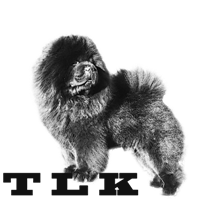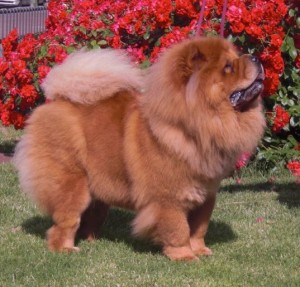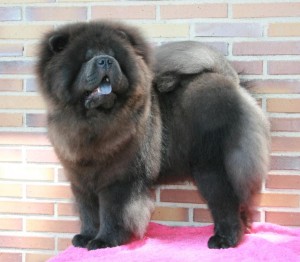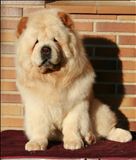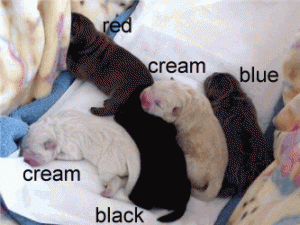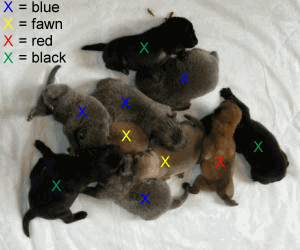Genetics in the Chow Chow, colors and layers
Free Translation and interpretation: genetics of color and coat in the Chow Chow breed content extracted from www.xin-feng.nl
The full original text is available at: http://www.xin-feng.nl/en/500e-genetics.html
Summary:
1.- Introduction genetic, basic knowledge about genetics
2.- Color Genes in the dog: genes A, E y K
2.- Color Genes in the dog: genes B, C, D, G, H, I, M, S y T
3.- The colors of chow chow: the black, red, blue, beige y crema
4.- Color reproduction.
5.- differences between red, cinnamon and cream
6.- The layers of the Chow Chow. Long hair and short hair.
7.- LA hair length in breeding the Chow Chow
introduction to genetics
To understand the following pages about the color and layer, requires some knowledge about genetics. In each cell of a living being is in chromosomes, where all information is stored on the appearance of the plant, animal o humano. Chromosomes come in pairs, one from the father and one mother. The part of the chromosome that carries the information for a given attribute is called gen (plural genes), as hair color genes, the gene for blue eyes. The place where this gene chromosome is, is called the locus (loci in a plural).
Dominant recessive
There are two types of genes: Dominant and recessive, if both types of genes are present, will show only the dominant. We named the dominant gene with a capital letter, recessive genes with a lowercase letter. There is always a dominant gene and one recessive, sometimes, a combination of two different genes gives an attribute between the other two, called intermediate. For example, some flowers are white and red colors. If a plant has two genes for red and white, its color is pink.
Some genes may affect how other genes may or may not be expressed, so that only a given allele may show whether an allele at another locus is present (or negatively, show only in the absence of an allele at this locus). Those genes that determine the appearance or non-appearance of other genes are called genes epistáticos.
terminology
The external appearance is called phenotype, while the genetic makeup is called genotype.
If the genes of a particular attribute or feature are the same is said to be homocigoto for that attribute / feature. However, if the two genes for a particular trait or attribute differ, which is said to be a heterocigotico for this attribute / feature.
Different genes for a given attribute is called alleles. All alleles at a given locus are called together series, and in the series, different alleles are named in order of dominance (the dominant allele first).
color genes in dogs: loci A, E y K
A: serie Agouti
a and = Red (ranks of the rojo rojo oscuro), suppresses the dark pigment, sometimes with dark red tips
a in = color lobo, eliminates the dark pigment in red and cream, hairs have red bands, cream and black.
a t = Black and tan, suppresses dark pigment in red too, but in other areas so that the coat is black, except around the eyes, mouth, the lower chest and legs
a = Recessive black, this is the black sheep dog in German and some other breeds
En el Chow Chow, shown allele a and and sometimes a.
It: Extension
It M = Mask
It G = Gray, found in Saluki and Afghan
It = Can cause light or dark pigmentation
and = Red recessive, suppresses the dark pigment, varies from red to cream
The Chow Chow can we find the two alleles E e
In Chow Chow cream color manifests as ee
The It M (mask) It is not the allele that causes the black mask on young chows, because Chow Chow mask fades when they get older, while if it were It M remain dark mask.
K: BLACK
K B = Dominant black
k br = Tabby, this is not a Chow Chow Color,
k = Other
En los Chow Chow dos alelos K B and k are present.
connection between the loci E, K y A
1 – if the locus E is of A locus and is aa, coat color is black
2 – if the locus E is of, the layer of cream (looks like the light red)
3 – if the locus E is EE the Of and the locus K allele is present K B, the coat is black
4 – If E is the locus EE the Of and K is the locus k br k br the k br k the coat is brindle, with streaks of lighter color determined by the color of the locus A
5 – otherwise, if the locus E is EE the Of and K is the locus kk, A locus determines coat color.
The Chow Chow's rule 4 not applicable, as the brindle color is not a recognized color.
It is very rare, but sometimes a red black cub born parents.
This can occur when a Chow Chow cream is poorly labeled red of which suppresses the K B.
It could also be black recessive (aa) which is present in the Chow Chow breed, This is the genetic explanation of a red black parents.
color genes in dogs: el B, C, D, G, H, I, M, S y T
B: Brown Series
The locus does not affect red.
B = Black
b = Brown (chocolate)
The Chow Chow only allele B it is present.
C: Colour range
The research found that C is the tyrosinase gene . No variation in this gene in dogs, though there is a variation in other species.
D: dilution series
D = Intense pigmentation
d = Diluted, diluted black blue black and red cinnamon
In the Chow Chow are two alleles D and d.
Some researchers claim that this locus affects only black color, but certainly in the Chow Chow is a gene that dilutes black and red, either the D series or yet another gene located.
Of Chow Chow is testaron blue sneakers Dd, this supports the idea that there is another gene that dilutes the layer Chow Chow.
G: Grey series.
G = Black hair graying with age
g = sin canas
Chow Chow in both alleles G y g may be present.
The G series is not yet found in the DNA, alleged alleles are based on results of breeding.
I: Intense Series
I = Deep red, undiluted
i = co-dominante, so it is lighter as ii Ii
Chow probably in both alleles are present in I i.
The number that is not yet in the DNA, alleged alleles are based on results of breeding.
loci H, M, S y T
H: Harlequin series
H = The harlequin-pattern in the Bulldog German
h = No harlequin pattern
M: Series Merle
MM = “White defective
Mm = Merle pattern.
mm = sin merle
S: Serie Moteado
S = Unstained (Solid color)
All other alleles give roughly spots.
T: serie Punteado
T = Marking on white spotted by area
t = Unstained
These loci, las series H, M, S and T in the Chow Chow appears only one allele each (h, m, S and t)
other possible loci
The Chow Chow often born red with a black mask, in this mask is tan pups blue. The mask vanishes when the older Chow. The Black Chows and blue mask could have also, but because of its color will not be displayed. The Cream Chows have visible mask. The gene is a dark mask It M, as seen in the mastiffs and pugs, but this mask does not fade. So there could be a FM: Fading Mask (Faded series masks), or an undiscovered allele at the E locus.
color loci race Chow
All have probably Chow Chow BB at locus B, hh locus in H, mm the locus M, SS at the S locus and tt locus in T.
The other loci for different colors are Chow Chow:
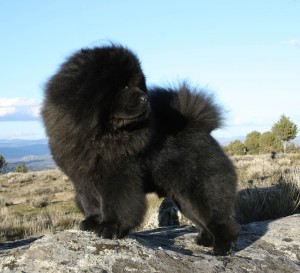
Black
A-locus: all combinations of a And y a
K-locus: K B K B the K B y k And
E-locus: EE the Of
D-locus: DD the Dd
Red
A-locus: a and a and the a anda
K-locus: k and k and
E-locus: EE the Of
D-locus: DD the Dd
Blue
A-locus: all combinations of a And y a
K-locus: K B K B the K B y k And
E-locus: EE the Of
D-locus: dd
In doos six Chow Chows blue DNA that were tested were Dd in the D-locus, this suggests that there must be another place for dilution in the layer of the Chows
Cinnamon
A-locus: a and a and the a and a
K-locus: k and k and
E-locus: EE the Of
D-locus: dd
A-locus: all combinations of a And y a
K-locus: all combinations of K B and kand
E-locus: of
D-locus: all combinations of D and d
It could be that this becomes apparent dilution cream a little lighter color.
recessive black in blue
(If this allele exists in Chow Chow, this would provide a logical explanation for some rare cases of black born out of the red for the parents and possibly light blue. This allele definitely exists in dogs)
A- locus: aa
K-locus: kk
E-locus: EE the Of
D-locus: DD the Dd of black and dd for blue
White
(It is one of the named colors in the FCI standard, I personally have never seen a pure white, always have a slightly darker ears, so they are cream. However when there is black a white recessive eesta be possible in the race Chow Cho, hence the existence of no- Chow Chow in white)
A locus: aa
K-locus: all combinations of K B and k and
E-locus: of
D-locus: all combinations of D and d
Possible color results in breeding Chow Chow
If you look at the color genes previously treated, these are the possible outcomes in breeding:
Black
From a cross of black x black, all colors are possible (if parents are carriers of the genes in particular for those colors).
The same applies to black x red, negro × azul, x black x black and cinnamon cream.
Black Puppies They are easy to recognize, just when they are born and are wet shiny black, and when dry, also.
Red
As previously described a black × red can give all colors.
red x red red can give, cinnamon and cream.
Red × Blue can give all colors.
Canela × Red can give red, cinnamon and cream.
Cream × Red can give all colors.
Red Cubs sound is often dark Birth, when dry, Color can be red light, rojo oscuro the dark brown. Some have a black mask at birth, however, this fades as they mature.
Blue
As described above Blue x Blue x black or red can give all colors.
Blue × Blue can give blue and cinnamon and, possibly cream, if parents are carriers of these genes in particular.
Canela × Blue can give blue and cream cinnamon and sometimes also.
Cream × blue can give all colors.
Blue Cubs son grises al nacer, when dry are bluish gray. His ears and nails are black.
As previously described cinnamon × black can give all colors
canela × rojo: red, cinnamon and cream,
Canela × azul: blue, sometimes cinnamon and cream.
X Canela Canela can probably cinnamon and cream.
Crema Canela × can give blue, beige y crema.
the cinnamon cubs They can look a lot like the blue at birth, both can appear gray. There (red-canela) and (blue-canela). The red-cinnamon are silver-red color sand, sometimes with a blue mask. Blue-cinnamon is a lot like a blue, but has a pink color in the cheeks and the back of the front legs.
Cream
As described previously cream x black, Cream × × blue red and cream can give all colors.
Crema Canela × can give blue, cinnamon and cream.
Cream the cream x usually cream, but there are a few cases of black.
Cubs cream They are easy to recognize, usually white with darker (red light) ears.
websites color genetics
Genetics of Coat Color in Dogs http://homepage.usask.ca/~schmutz/dogcolors.html
First Canine Genetics http://www.tenset.co.uk / Great Danes / indexus.html
Canine Color Genetics http://bowlingsite.mcf.com/Genetics/ColorGen.html
Coat Color http://www.chromadane.com/standardcoat.htm
Books color genetics
Clarence C. Little, The Inheritance of Coat Color in Dogs
Roy Robinson, Genetics for Dog Breeders
Malcom B. Willis, Genetics of the Dog
Malcom B. Willis, Practical Genetics for Dog Breeders
short hair and long hair
The only difference between long hair and short hair in the Chow Chow is the length of the.
Chow Chow the long hair looks larger because of their long fur.
The long-haired Chow Chow is the best known variety, but short hair is also becoming popular nowadays.. In Spain are judged together. Straight hair in the ring is less showy and more difficult to show that long hair as it is more complicated to hide any defects. However, the long-haired Chow requires more preparation and grooming.
In the both layers are mixed breeding, so in a litter may have long hair and short hair..
recognize short hair and long hair after birth
It is possible to distinguish long hair short a few days old puppies, the short hair have more hair vertical, type teddy, without bright hairs on his head and long hair have more hair lying, silky and shiny on his head.
It is difficult to see the difference at first, but after a little practice you will find it not so difficult.
After these early days you have to wait until the puppies are of 4 a 5 weeks old to see the difference again. At that age the coat of long hair is already significantly different from those of short hair.
Genetics layer breed Chow Chow
The genetics of coat length seems very simple, long hair is the dominant factor and this is the usual. The crossing of two long-haired dogs only be born of long hair, Shorthaired dogs born of long and short hair but there are some cases of short-haired dogs born two longhaired, and had short hair in her litter. These cases are too numerous to ignore this fact, random mutations or call.
The difference between long and short hair is not always clear, no short hair with a long soft coat and no long hair with a short rough coat.
Could it be possible that the short hair with a long coat of cort hair are heterozygous, Kk so could be an intermediate layer.
Possible there is a yet unknown gene involved, influencing the length of the shortest layer making it more long.
For all this the exact genetic makeup to hair length is unknown, according to this circumstance working with a simplified version:
the gene for short hair (The) is dominant, the gene for long hair (the) is recessive.
This gives us three possible varieties Genetics:
LL both genes = homozygous short hair short
Ll Short hair gene and the other heterozygote long = short
ll along both long genes = homozygous
Possible outcomes in breeding
A short homozygous (LL) given in all cases only short hair puppies:
LL × ll the da 100% Ll
LL × Ll da 50% LL y 50% Ll
LL × LL da 100% LL
A short Heterozygous (Ll) can give young long hair and short hair:
Ll x ll gives you the 50% and 50% Ll ll
Ll × LL da 25% LL, 50%Ll y 25% ll
A long hair (ll) × largo (ll) da el 100% long (ll)
